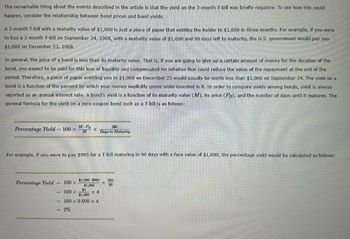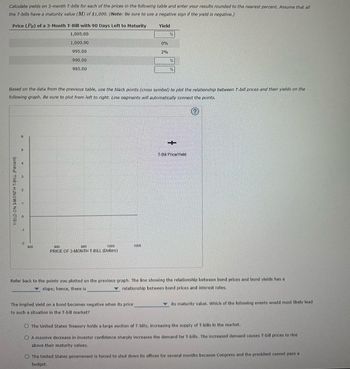
ENGR.ECONOMIC ANALYSIS
14th Edition
ISBN: 9780190931919
Author: NEWNAN
Publisher: Oxford University Press
expand_more
expand_more
format_list_bulleted
Question
Please answer everything in the photos including the graph.

Transcribed Image Text:The remarkable thing about the events described in the article is that the yield on the 3-month T-bill was briefly negative. To see how this could
happen, consider the relationship between bond prices and bond yields.
A 3-month T-bill with a maturity value of $1,000 is just a piece of paper that entitles the holder to $1,000 in three months. For example, if you were
to buy a 3-month T-bill on September 24, 2008, with a maturity value of $1,000 and 90 days left to maturity, the U.S. government would pay you
$1,000 on December 23, 2008.
In general, the price of a bond is less than its maturity value. That is, if you are going to give up a certain amount of money for the duration of the
bond, you expect to be paid for this loss of liquidity and compensated for inflation that could reduce the value of the repayment at the end of the
period. Therefore, a piece of paper entitling you to $1,000 on December 23 would usually be worth less than $1,000 on September 24. The yield on a
bond is a function of the percent by which your money implicitly grows while invested in it. In order to compare yields among bonds, yield is always
reported as an annual interest rate. A bond's yield is a function of its maturity value (M), its price (PB), and the number of days until it matures. The
general formula for the yield on a zero-coupon bond such as a T-bill is as follows:
Percentage Yield = 100 x
Percentage Yield
M-PB
M
X
For example, if you were to pay $995 for a T-bill maturing in 90 days with a face value of $1,000, the percentage yield would be calculated as follows:
= 2%
$1,000-$995
$1,000
x 4
100 x
100 x
$5
$1,000
100 x 0.005 X 4
360
Days to Maturity
X
360
90

Transcribed Image Text:Calculate yields on 3-month T-bills for each of the prices in the following table and enter your results rounded to the nearest percent. Assume that all
the T-bills have a maturity value (M) of $1,000. (Note: Be sure to use a negative sign if the yield is negative.)
Price (PB) of a 3-Month T-Bill with 90 Days Left to Maturity
1,005.00
1,000.00
995.00
990.00
985.00
6
5
YIELD ON 3-MONTH T-BILL (Percent)
.。. N w
Based on the data from the previous table, use the black points (cross symbol) to plot the relationship between T-bill prices and their yields on the
following graph. Be sure to plot from left to right. Line segments will automatically connect the points.
(?)
-2
985
990
995
1000
PRICE OF 3-MONTH T-BILL (Dollars)
Yield
1005
The implied yield on a bond becomes negative when its price
to such a situation in the T-bill market?
0%
2%
%
%
+
T-Bill Price/Yield
Refer back to the points you plotted on the previous graph. The line showing the relationship between bond prices and bond yields has a
slope; hence, there is
relationship between bond prices and interest rates.
its maturity value. Which of the following events would most likely lead
The United States Treasury holds a large auction of T-bills, increasing the supply of T-bills in the market.
OA massive decrease in investor confidence sharply increases the demand for T-bills. The increased demand causes T-bill prices to rise
above their maturity values.
O The United States government is forced to shut down its offices for several months because Congress and the president cannot pass a
budget.
Expert Solution
This question has been solved!
Explore an expertly crafted, step-by-step solution for a thorough understanding of key concepts.
This is a popular solution
Trending nowThis is a popular solution!
Step by stepSolved in 4 steps with 3 images

Knowledge Booster
Learn more about
Need a deep-dive on the concept behind this application? Look no further. Learn more about this topic, economics and related others by exploring similar questions and additional content below.Similar questions
- Financial statements, what are they? what are they used for? Why are they important? What are the different types and the purpose of each?arrow_forwardWhat is a CD and how do they work?arrow_forwardYou are looking for a car to lease. Your income is $3,000 per month, and you know that you should not spend more than 20 percent of your income on a car payment. You have found four deals in the table below. options Location Monthly Rent Toyota Camry $400 Lincoln MKZ $660 Ford Fusion $380 BMW 740 $720 Instructions: In order to receive full credit, you must make a selection for each option. For the correct answer(s), click the box once to place a checkmark. For the incorrect answer(s), click the option twice to empty the box. Suppose you adhere to the 20 percent guideline but also receive a $100 monthly allowance from your parents towards your car payment, which option(s) fall within your budget? Group of answer choices Toyota Camry Lincoln MKZ Ford Fusion BMW 740arrow_forward
arrow_back_ios
SEE MORE QUESTIONS
arrow_forward_ios
Recommended textbooks for you

 Principles of Economics (12th Edition)EconomicsISBN:9780134078779Author:Karl E. Case, Ray C. Fair, Sharon E. OsterPublisher:PEARSON
Principles of Economics (12th Edition)EconomicsISBN:9780134078779Author:Karl E. Case, Ray C. Fair, Sharon E. OsterPublisher:PEARSON Engineering Economy (17th Edition)EconomicsISBN:9780134870069Author:William G. Sullivan, Elin M. Wicks, C. Patrick KoellingPublisher:PEARSON
Engineering Economy (17th Edition)EconomicsISBN:9780134870069Author:William G. Sullivan, Elin M. Wicks, C. Patrick KoellingPublisher:PEARSON Principles of Economics (MindTap Course List)EconomicsISBN:9781305585126Author:N. Gregory MankiwPublisher:Cengage Learning
Principles of Economics (MindTap Course List)EconomicsISBN:9781305585126Author:N. Gregory MankiwPublisher:Cengage Learning Managerial Economics: A Problem Solving ApproachEconomicsISBN:9781337106665Author:Luke M. Froeb, Brian T. McCann, Michael R. Ward, Mike ShorPublisher:Cengage Learning
Managerial Economics: A Problem Solving ApproachEconomicsISBN:9781337106665Author:Luke M. Froeb, Brian T. McCann, Michael R. Ward, Mike ShorPublisher:Cengage Learning Managerial Economics & Business Strategy (Mcgraw-...EconomicsISBN:9781259290619Author:Michael Baye, Jeff PrincePublisher:McGraw-Hill Education
Managerial Economics & Business Strategy (Mcgraw-...EconomicsISBN:9781259290619Author:Michael Baye, Jeff PrincePublisher:McGraw-Hill Education


Principles of Economics (12th Edition)
Economics
ISBN:9780134078779
Author:Karl E. Case, Ray C. Fair, Sharon E. Oster
Publisher:PEARSON

Engineering Economy (17th Edition)
Economics
ISBN:9780134870069
Author:William G. Sullivan, Elin M. Wicks, C. Patrick Koelling
Publisher:PEARSON

Principles of Economics (MindTap Course List)
Economics
ISBN:9781305585126
Author:N. Gregory Mankiw
Publisher:Cengage Learning

Managerial Economics: A Problem Solving Approach
Economics
ISBN:9781337106665
Author:Luke M. Froeb, Brian T. McCann, Michael R. Ward, Mike Shor
Publisher:Cengage Learning

Managerial Economics & Business Strategy (Mcgraw-...
Economics
ISBN:9781259290619
Author:Michael Baye, Jeff Prince
Publisher:McGraw-Hill Education